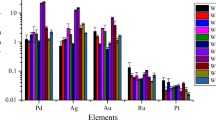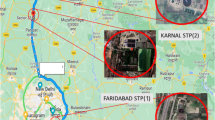Abstract
The distribution behaviors of metals in bio-oils derived from sewage sludge (SS) by liquefaction with different solvents (ethanol, methanol, or acetone) and by pyrolysis at different temperatures (550–850 °C) were investigated. The concentrations of crust metals (K, Na, Ca, Mg, Fe, and Al) in bio-oils were much higher than those of the anthropogenic metals (Cu, Zn, Pb, Cd, Cr, Ni, V, Mn, Ba, Co, Ti, Sn, As, and Hg), but the anthropogenic metals were more inclined to distribute in bio-oil phase compared with crust metals. The anthropogenic metals in bio-oils can be divided in three groups in terms of the distribution similarities according to Cluster analysis: (A) Cu, Co, Ni, V, and Sn; (B) Cr, Ti, Mn, and Ba; (C) Pb, Cd, As, Hg, and Zn. Cu, Cr, Hg, Cd, V, Co, and Sn distributed in the liquefaction/pyrolysis bio-oils accounted for as high as 5–20 % of the metals in SS and were evaluated “moderate enrichment” by the enrichment factors method. According to the potential ecological risk index (PERI) method, Hg presented very high risk, Cu presented moderate risk, and Cd presented low to moderate risk; and the overall risk levels of these bio-oils were very high risk (except P550, presented considerable risk).




Similar content being viewed by others
References
Bunt JR, Waanders FB (2008) Trace element behaviour in the Sasol–Lurgi MK IV FBDB gasifier. Part 1—the volatile elements: Hg, As, Se, Cd and Pb. Fuel 87:2374–2387. doi:10.1016/j.fuel.2008.01.017
Chiang H-L, Lin K-H, Lai N, Shieh Z-X (2014) Element and PAH constituents in the residues and liquid oil from biosludge pyrolysis in an electrical thermal furnace. Sci Total Environ 481:533–541. doi:10.1016/j.scitotenv.2014.02.083
De Andrade E, Alves JC, Izaias S et al (2010) Assessment of trace metals contamination in estuarine sediments using a sequential extraction technique and principal component analysis. Microchem J 96:50–57. doi:10.1016/j.microc.2010.01.018
Feng L, Luo J, Chen Y (2015) Dilemma of sewage sludge treatment and disposal in China. Environ Sci Technol 49:4781–4782. doi:10.1021/acs.est.5b01455
Fonts I, Gea G, Azuara M et al (2012) Sewage sludge pyrolysis for liquid production: a review. Renew Sustain Energy Rev 16:2781–2805. doi:10.1016/j.rser.2012.02.070
Hakanson L (1980) Ecological risk index for aquatic pollution control: a sedimentological approach. Water Res 14:975–1001
Huang H, Yuan X, Zeng G et al (2011) Quantitative evaluation of heavy metals’ pollution hazards in liquefaction residues of sewage sludge. Bioresour Technol 102:10346–10351. doi:10.1016/j.biortech.2011.08.117
Huang H, Yuan X, Zhu H et al (2013) Comparative studies of thermochemical liquefaction characteristics of microalgae, lignocellulosic biomass and sewage sludge. Energy 56:52–60. doi:10.1016/j.energy.2013.04.065
Huang H, Yuan X, Li B et al (2014) Thermochemical liquefaction characteristics of sewage sludge in different organic solvents. J Anal Appl Pyrolysis 109:176–184. doi:10.1016/j.jaap.2014.06.015
Jena U, Das KC (2011) Comparative evaluation of thermochemical liquefaction and pyrolysis for bio-oil production from microalgae. Energy Fuel 25:5472–5482. doi:10.1021/ef201373m
Kistler RC, Widmer F, Brunner PH (1987) Behavior of chromium, nickel, copper, zinc, cadmium, mercury, and lead during the pyrolysis of sewage sludge. Environ Sci Technol 21:704–708. doi:10.1021/es00161a012
Leng L, Yuan X, Huang H et al (2014) The migration and transformation behavior of heavy metals during the liquefaction process of sewage sludge. Bioresour Technol 167:144–50. doi:10.1016/j.biortech.2014.05.119
Li X, Wu H, Hayashi J, Li C-Z (2004) Volatilisation and catalytic effects of alkali and alkaline earth metallic species during the pyrolysis and gasification of Victorian brown coal. Part VI. Further investigation into the effects of volatile-char interactions. Fuel 83:1273–1279. doi:10.1016/j.fuel.2003.12.009
Li H, Yuan X, Zeng G et al (2010) The formation of bio-oil from sludge by deoxy-liquefaction in supercritical ethanol. Bioresour Technol 101:2860–2866. doi:10.1016/j.biortech.2009.10.084
Park HJ, Heo HS, Park YK et al (2010) Clean bio-oil production from fast pyrolysis of sewage sludge: effects of reaction conditions and metal oxide catalysts. Bioresour Technol 101(Suppl):S83–85. doi:10.1016/j.biortech.2009.06.103
Quyn DM, Wu H, Bhattacharya SP, Li C (2002) Volatilisation and catalytic effects of alkali and alkaline earth metallic species during the pyrolysis and gasification of Victorian brown coal. Part II. Effects of chemical form and valence. Fuel 81:151–158
Reinik J, Irha N, Steinnes E et al (2014) Release of 22 elements from bottom and fly ash samples of oil shale fueled PF and CFB boilers by a two-cycle standard leaching test. Fuel Process Technol 124:147–154. doi:10.1016/j.fuproc.2014.03.011
Saeedi M, Li LY, Salmanzadeh M (2012) Heavy metals and polycyclic aromatic hydrocarbons: pollution and ecological risk assessment in street dust of Tehran. J Hazard Mater 227–228:9–17. doi:10.1016/j.jhazmat.2012.04.047
Teng Y, Wu J, Lu S et al (2014) Soil and soil environmental quality monitoring in China: a review. Environ Int 69:177–199. doi:10.1016/j.envint.2014.04.014
Tian Y, Zuo W, Ren Z, Chen D (2011) Estimation of a novel method to produce bio-oil from sewage sludge by microwave pyrolysis with the consideration of efficiency and safety. Bioresour Technol 102:2053–2061. doi:10.1016/j.biortech.2010.09.082
Trinh TN, Jensen PA, Dam-Johansen K et al (2013) Influence of the pyrolysis temperature on sewage sludge product distribution, bio-oil, and char properties. Energy Fuel 27:1419–1427. doi:10.1021/ef301944r
Wang Y, Huang K, Li C et al (2003) Emissions of fuel metals content from a diesel vehicle engine. Atmos Environ 37:4637–4643. doi:10.1016/j.atmosenv.2003.07.007
Wang X, Chen L, Xia S, Zhao J (2008) Changes of Cu, Zn, and Ni chemical speciation in sewage sludge co-composted with sodium sulfide and lime. J Environ Sci (China) 20:156–160
Wu H, Quyn DM, Li C (2002) Volatilisation and catalytic effects of alkali and alkaline earth metallic species during the pyrolysis and gasification of Victorian brown coal. Part III. The importance of the interactions between volatiles and char at high temperature. Fuel 81:1033–1039
Wu H, Hayashi J, Chiba T (2004) Volatilisation and catalytic effects of alkali and alkaline earth metallic species during the pyrolysis and gasification of Victorian brown coal. Part V. Combined effects of Na concentration and char structure on char reactivity. Fuel 83:23–30. doi:10.1016/S0016-2361(03)00238-2
Xie X-D, Min X-B, Chai L-Y et al (2013) Quantitative evaluation of environmental risks of flotation tailings from hydrothermal sulfidation-flotation process. Environ Sci Pollut Res 20:6050–6058. doi:10.1007/s11356-013-1643-8
Xu Z, Ni S, Tuo X, Zhang C (2008) Calculation of heavy metals’ toxicity coefficient in the evaluation of potential ecological risk index. Environ Sci Technol (in Chinese) 31:31,112–115
Xu ZR, Zhu W, Htar SH (2012) Partial oxidative gasification of municipal sludge in subcritical and supercritical water. Environ Technol 33:1217–1223. doi:10.1080/09593330.2011.618933
Yang G, Zhang G, Wang H (2015) Current state of sludge production, management, treatment and disposal in China. Water Res 78:60–73. doi:10.1016/j.watres.2015.04.002
Yuan X, Huang H, Zeng G et al (2011a) Total concentrations and chemical speciation of heavy metals in liquefaction residues of sewage sludge. Bioresour Technol 102:4104–4110. doi:10.1016/j.biortech.2010.12.055
Yuan X, Wang J, Zeng G et al (2011b) Comparative studies of thermochemical liquefaction characteristics of microalgae using different organic solvents. Energy 36:6406–6412. doi:10.1016/j.energy.2011.09.031
Yuan X, Leng L, Huang H et al (2015) Speciation and environmental risk assessment of heavy metal in bio-oil from liquefaction/pyrolysis of sewage sludge. Chemosphere 120:645–652. doi:10.1016/j.chemosphere.2014.10.010
Zhai Y, Liu X, Chen H et al (2014) Source identification and potential ecological risk assessment of heavy metals in PM2.5 from Changsha. Sci Total Environ 493:109–115. doi:10.1016/j.scitotenv.2014.05.106
Zhang Q, Ye J, Chen J et al (2014) Risk assessment of polychlorinated biphenyls and heavy metals in soils of an abandoned e-waste site in China. Environ Pollut 185:258–265. doi:10.1016/j.envpol.2013.11.003
Acknowledgments
This work was supported by the National Natural Science Foundation of China under Grant Nos. 21276069 and 71221061, and the Specialized Research Fund for the Doctoral Program of Higher Education, China (No. 20120161130002).
Compliance with ethical standards
The authors declare that they have no conflict of interest. This article does not contain any studies with human participants or animals performed by any of the authors. Informed consent was obtained from all individual participants included in the study.
Author information
Authors and Affiliations
Corresponding author
Additional information
Responsible editor: Angeles Blanco
Electronic supplementary material
Below is the link to the electronic supplementary material.
ESM 1
(DOC 111 kb)
Rights and permissions
About this article
Cite this article
Leng, L., Yuan, X., Huang, H. et al. Distribution behavior and risk assessment of metals in bio-oils produced by liquefaction/pyrolysis of sewage sludge. Environ Sci Pollut Res 22, 18945–18955 (2015). https://doi.org/10.1007/s11356-015-5031-4
Received:
Accepted:
Published:
Issue Date:
DOI: https://doi.org/10.1007/s11356-015-5031-4




